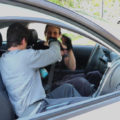As we frequently discuss at class at Full Potential Martial Arts, self defense starts much before the moment when we subject to a physically attack. Self defense starts with us being aware and vigilant to what is going on around us, with us reading other people, and with us making sure that we are projecting the right image of ourselves. Many crimes are crimes of opportunity, and perpetrators of such crimes will choose a victim that they think will suit their purposes — be it a mugging, a rape or any other attack. This, in law enforcement circles, is called the “interview”. You may not know it, but the perpetrator is “interviewing” you. By observing you, and possibly in putting you through some tests — verbal or physical — the perpetrator deciding whether you will make a good victim. This is one interview that you definitely want to “fail”, and failing the interview is your best chance to apply practical self defense skills without having to actually fight. You want to perpetrator to think that he or she is better off skipping you, and looking for a different victim.
A recent article, published by the BBC last week “How the way we walk can increase risk of being mugged” cites academic research about the effects of one’s walking style on his or her desirability as a as a good target for mugging. This reminded me of seminar research in this area: In the 1984, Betty Grayson and Morris Stein, researchers at Hofstra University and New York University, respectively, published a paper entitled “Attracting Assault: Victim’s Nonverbal Cues”. Grayson and Stein presented convicted felons short videos of pedestrians walking on a city sidewalk. They found that, within seven seconds, a criminal could decide whether a person would make a good target for a mugging, rape or murder. Furthermore, the criminals were in consensus on who were the “good” victims, and who should be “passed”. More surprisingly, it was not initially apparent what criteria the criminals used in their selection. For example, some large men were selected as “good victims”, while some small, slightly built women were passed over. When asked, the convicts could not explain their selection, as their “victim interview” process was predominantly made unconsciously. Grayson and Stein were able to analyze the videos, and discovered that victims and non victims were separated by the way they walked, by their posture, and by their gaze. Namely, whereas non-victims had a natural stride, walked at a normal pace (not too fast and not too slow), and exhibited fluid body movements, victims had one or more of the following: an exaggerated stride (either too long or too short), walked at an off pace (too slowly, or too fast — signalling fear), lacked fluidity in their movement, had a slumped posture, gazed downward, or avoided eye contact. These traits implied an ideal target for a predator, and as martial artists, our first line of self defense is to avoid exhibiting them.
Additional interesting research in the area of walking stride and vulnerability in self-defense situations was conducted in 2002 by Rebekah Gunns, Lucy Johnson and Stephen Hudson (“Victim Selection and Kinematics: A Point-Light Investigation of Vulnerability to Attack”, published in the Journal of Nonverbal Behavior). Gunns, Johnson and Hudson showed that even when all other information is removed, criminal observing a person’s stride can determine whether that person makes for a good victim. Just like you and I can often recognize a friend from a distance by observing their stride, criminal can spot a good victim. The way we move makes a huge impact on how we are viewed, and proper knowledge of movement is important in any self-defense program. Although (unfortunately) many self defense classes don’t train this aspect of self-defense, it is possible to change the way we walk so as to appear less vulnerable. This was shown in a 2006 academic paper by Lucy Johnson and her collaborators, entitled “Changing Kinematics as a Means of Reducing Vulnerability to Physical Attack” (was published in The Journal of Applied Social Psychology).
We highly recommend that self-defense classes incorporate teaching students how to improve their walking style in order to appear less desirable to criminals — be it in self defense training for women, teens, or men, in San Diego and elsewhere. It is a simple, yet highly effective line of self defense. Learning how to walk with better synchrony and higher energy can literally save your life one day!
Full Potential Martial Arts offers self-defense classes and training in San Diego, to adults and teenagers.






Wow! I didn’t realize that how I walk matters so much.